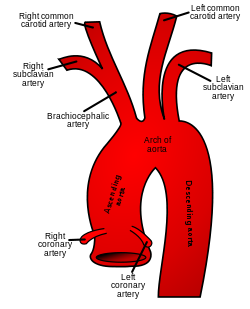Top Qs
Timeline
Chat
Perspective
Dysphagia lusoria
Medical condition From Wikipedia, the free encyclopedia
Remove ads
Dysphagia lusoria (or Bayford-Autenrieth dysphagia) is an abnormal condition characterized by difficulty in swallowing caused by an aberrant right subclavian artery. It was discovered by David Bayford in 1761 and first reported in a paper by the same in 1787.[1]
Pathophysiology
During development of aortic arch, if the proximal portion of the right fourth arch disappears instead of distal portion, the right subclavian artery will arise as the last branch of aortic arch. It then courses behind the esophagus (or rarely in front of esophagus, or even in front of trachea) to supply blood to right arm. This causes pressure on esophagus and results in dysphagia. It can sometimes result in upper gastrointestinal tract bleeding.[2] Investigation of choice - CT angiography
Remove ads
Treatment
Surgical repair is performed. Reconstruction or ligation of aberrant right subclavian artery by sternotomy/by neck approach.[citation needed]
Eponym
David Bayford called it dysphagia lusoria because in Latin, lusus naturæ means sports of nature, freak of nature, or natural anomaly.[3] Bayford-Autenrieth dysphagia is eponym for Bayford and Autenrieth.[citation needed]
See also
References
External links
Wikiwand - on
Seamless Wikipedia browsing. On steroids.
Remove ads

